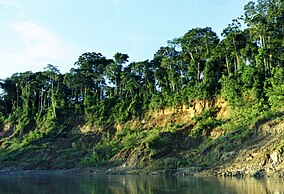Manú National Park
| Manu National Park | |
|---|---|
|
IUCN category II (national park)
|
|

View of a riverbank in Manu National Park
|
|
| Location within Peru | |
| Location | Madre de Dios Region, Cusco Region, Peru |
| Nearest city | Cusco |
| Coordinates | 11°51′23″S 71°43′17″W / 11.85639°S 71.72139°WCoordinates: 11°51′23″S 71°43′17″W / 11.85639°S 71.72139°W |
| Area | 1,716,295 ha (6,626.65 sq mi) |
| Established | May 29, 1973 (by 644-73-AG) |
| Governing body | SERNANP |
| Type | Natural |
| Designated | 1987 (11th session) |
| Reference no. | 402 |
| State Party | Peru |
| Region | Latin America and the Caribbean |
Manú National Park (Spanish: Parque Nacional del Manu) is a biosphere reserve located in Madre de Dios and Paucartambo, Cusco. Before becoming an area protected by the Peruvian government, the Manú National Park was conserved thanks to its inaccessibility. The park remains fairly inaccessible by road to this day. In 1977, UNESCO recognised it as a Biosphere Reserve and in 1987, it was pronounced a World Heritage Site. It is the largest National Park in Peru, covering an area of 15,328 km². The Biosphere Reserve includes an additional 2,570 km², and a further 914 km² are included in a "Cultural Zone" (which also is afforded a level of protection), bringing the total area up to 18,811 km².
The park protects several ecological zones ranging from as low as 150 meters above sea level in parts of the Southwest Amazon moist forests to Peruvian Yungas at middle elevations to Central Andean wet puna at altitudes of 4200 meters. Because of this topographical range, it has one of highest levels of biodiversity of any park in the world. Overall, more than 15,000 species of plants are found in Manú, and up to 250 varieties of trees have been found in a single hectare. The reserve is a destination for birdwatchers from all over the world, as it is home to over 1000 species of birds, more than the number of bird species found in the United States and Canada combined and almost 10% of the world's total bird species. It is also acclaimed as having one of the highest abundances of land vertebrates ever found in Latin American tropical forests.
The park encompasses virtually the entire watershed of the Manú River, from the sources of its tributaries high in the Andes, to its emptying into the Madre de Dios River. As the surrounding area is largely undeveloped, the only direct access to the lowlands is by boat, up the Manú River. This singular entry point is easily patrolled by park guards. The road Cusco-Paucartambo-Shintuya borders the southern section of the park and provides access to high-Andean ecosystems, such as grasslands (puna) and montane forest and scrub.
...
Wikipedia

